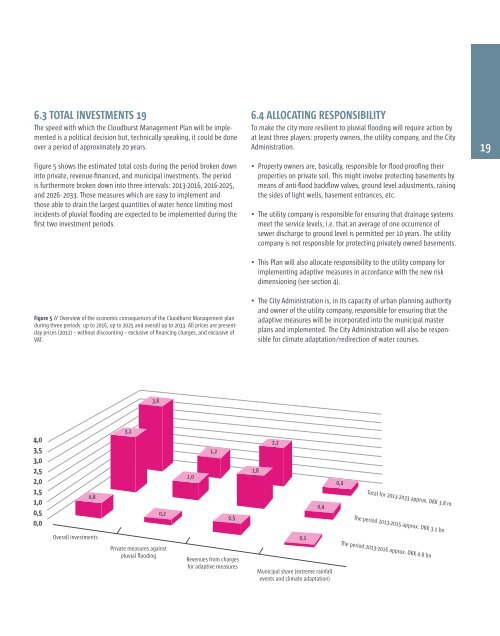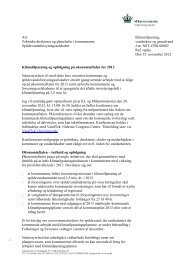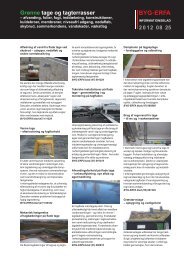Cloudburst Management Plan - Climate Change Adaptation
Cloudburst Management Plan - Climate Change Adaptation
Cloudburst Management Plan - Climate Change Adaptation
Create successful ePaper yourself
Turn your PDF publications into a flip-book with our unique Google optimized e-Paper software.
6.3 Total Investments 19<br />
The speed with which the <strong>Cloudburst</strong> <strong>Management</strong> <strong>Plan</strong> will be implemented<br />
is a political decision but, technically speaking, it could be done<br />
over a period of approximately 20 years.<br />
Figure 5 shows the estimated total costs during the period broken down<br />
into private, revenue-financed, and municipal investments. The period<br />
is furthermore broken down into three intervals: 2013-2016, 2016-2025,<br />
and 2026- 2033. Those measures which are easy to implement and<br />
those able to drain the largest quantities of water hence limiting most<br />
incidents of pluvial flooding are expected to be implemented during the<br />
first two investment periods.<br />
Figure 5 // Overview of the economic consequences of the Cluodburst <strong>Management</strong> plan<br />
during three periods: up to 2016, up to 2025 and overall up to 2033. All prices are presentday<br />
prices (2012) – without discounting – exclusive of financing charges, and exclusive of<br />
VAT.<br />
6.4 Allocating Responsibility<br />
To make the city more resilient to pluvial flooding will require action by<br />
at least three players: property owners, the utility company, and the City<br />
Administration.<br />
• Property owners are, basically, responsible for flood-proofing their<br />
properties on private soil. This might involve protecting basements by<br />
means of anti-flood backflow valves, ground level adjustments, raising<br />
the sides of light wells, basement entrances, etc.<br />
• The utility company is responsible for ensuring that drainage systems<br />
meet the service levels, i.e. that an average of one occurrence of<br />
sewer discharge to ground level is permitted per 10 years. The utility<br />
company is not responsible for protecting privately owned basements.<br />
• This <strong>Plan</strong> will also allocate responsibility to the utility company for<br />
implementing adaptive measures in accordance with the new risk<br />
dimensioning (see section 4).<br />
• The City Administration is, in its capacity of urban planning authority<br />
and owner of the utility company, responsible for ensuring that the<br />
adaptive measures will be incorporated into the municipal master<br />
plans and implemented. The City Administration will also be responsible<br />
for climate adaptation/redirection of water courses.<br />
19<br />
3,8<br />
4,0<br />
3,5<br />
3,0<br />
2,5<br />
2,0<br />
1,5<br />
1,0<br />
0,5<br />
0,0<br />
0,8<br />
3,1<br />
0,2<br />
1,0<br />
1,2<br />
0,5<br />
1,8<br />
2,2<br />
0,4<br />
0,4<br />
Total for 2013-2033 approx. DKK 3.8 m<br />
The period 2013-2015 approx. DKK 3.1 bn<br />
Overall investments<br />
0,1<br />
Private measures against<br />
pluvial flooding<br />
Revenues from charges<br />
for adaptive measures<br />
Municipal share (extreme rainfall<br />
events and climate adaptation)<br />
The period 2013-2016 approx. DKK 0.8 bn

















